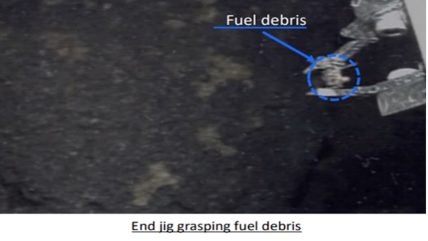
Tokyo Electric Power Company Holdings (Tepco) has extracted the first sample of nuclear fuel debris from the containment vessel at unit 2 of the Fukushima Daiichi NPP. Tepco successfully retrieved sample using the specially developed device holding a small amount of fallen debris.
This success follows several earlier failed attempts since the plant in Fukushima Prefecture suffered a meltdown following the massive March 2011 earthquake and tsunami in which three reactors suffered a reactor meltdown. Tepco in September had suspended attempts for a second time to collect melted nuclear fuel from unit 2 after two cameras on the robotic device ceased to function. Four days before, Tepco had begun a two-week operation to retrieve the first sample of melted fuel debris.
The operation was initially scheduled to begin on 22 August but was suspended when workers noticed that five 1.5-metre pipes to be used to push the robot into the reactor had been arranged in the wrong order. The equipment was subsequently reassembled in the right order. Tepco initially planned to conduct the experimental removal work in 2021, but it was postponed by about three years due to delays in the development of necessary devices overseas and other preparations.
Preparations for fuel removal from unit 2 started in 2017 when a remotely operated camera on a telescopic probe took photos of the area directly below the pressure vessel – the pedestal. These showed a black mass and deposits near a grating in the pedestal area, which was thought to be melted fuel. Tepco says that from the results of primary containment vessel internal investigations there appear to be pebble‐like and clay‐like deposits on the floor inside the pedestal.
“The deposits appear to be molten material that has solidified, but no deformation of the stainless steel cable trays has been found, so it is assumed that not enough heat was generated to cause the structures to deform. Therefore, it is assumed that the fuel debris contains a lot of metal elements (structural material elements).”
Removal has proved challenging, requiring the development of a special robotic arm, Telesco, to extract material from the reactor. Tepco grabbed the debris using a claw-like gripper tool attached to the tip of a retrieval device shaped like a fishing rod. The end jig camera on the gripper tool was used to determine the size of the fuel debris sampled, which was around 5 millimetres and weighed around 3 grams.
The collected samples will be put into a negative pressure glovebox, where they will be subjected to various measurements. These include the mass of the sampled fuel debris and the amount of hydrogen being generated in order to verify safety for the transport of fuel debris for further investigation. The sample will be put into a polyethylene specimen container and then placed inside a vase‐like container (polypropylene, lead) while inside the glovebox.
After that it will be sealed inside a bag made of polyvinyl chloride and placed inside the transport container and loaded onto a transport vehicle. “Prior to transport we will confirm that surface dose rates and surface contamination density levels fall below legal limits with the fuel debris inside the container,” Tepco says. “The transport container will remain sealed even when subjected to various test conditions as legally required by law.”
The fuel debris will be analysed at off‐site analysis centres including Japan Atomic Energy Agency’s Oarai Research & Development Institute; Nuclear Science Research Institute; Nippon Nuclear Fuel Development Co; and MHI Nuclear Development Corporation.
The results from overall analysis performed at the Oarai Research & Development Institute (fuel debris surface element distribution, etc.) should be compiled in several months, and the results of analyses performed at other facilities should be compiled in approximately one year. Tepco says the time required for analysis may vary depending on work conditions and analysis results.
Analyses will focus on the three following objectives:
- Directly ascertain the attributes of fuel debris from the sampling location;
- Examine the process by which the fuel debris was generated (origin, temperature, atmosphere, etc) to deduce information about the area in the vicinity of the sampling location and the areas (routes) that the fuel debris passed through when it was formed;
- Continue to analyse fuel debris retrieved in the future in order to better understand the attributes over a wide area and efficiently ascertain the attributes of all fuel debris.
During the trial retrieval, analysis will focus mainly on the composition of fuel debris and the results will be leveraged to deliberate sub-criticality and exposure, etc. during the later phase of the retrieval process. Information will be gradually obtained during the course of fuel debris retrieval, which will be carried out in a step‐by‐step fashion based on internal investigation results. The scale of retrieval will be gradually enlarged step‐by‐step while leveraging existing safety equipment and confirming that safety is being ensured.
“The knowledge we obtain during each step will be reflected in later steps as we acquire new information,” Tepco says. “The main purpose of trial fuel debris retrieval is to obtain information on the composition of fuel debris. We also aim to accumulated experience with fuel debris analysis that will help us to improve the accuracy of analysis/assessment.” By analysing the attributes of the sampled fuel debris “we will directly ascertain information such as the composition of debris at the sampling location and radioactivity density, etc.”
Analysis will be performed to examine attributes pertaining to the origin of sampled fuel debris (formation process). The results will be used to deduce information on conditions inside the reactor in areas that the fuel debris passed through when it formed (origin, temperature, atmosphere). This will be used to deduce information about the area in the vicinity of the sampling location and other related areas. “We will continue to analyse fuel debris retrieved in the future in order to better understand the attributes over a wide area and efficiently ascertain the attributes of all fuel debris.”






